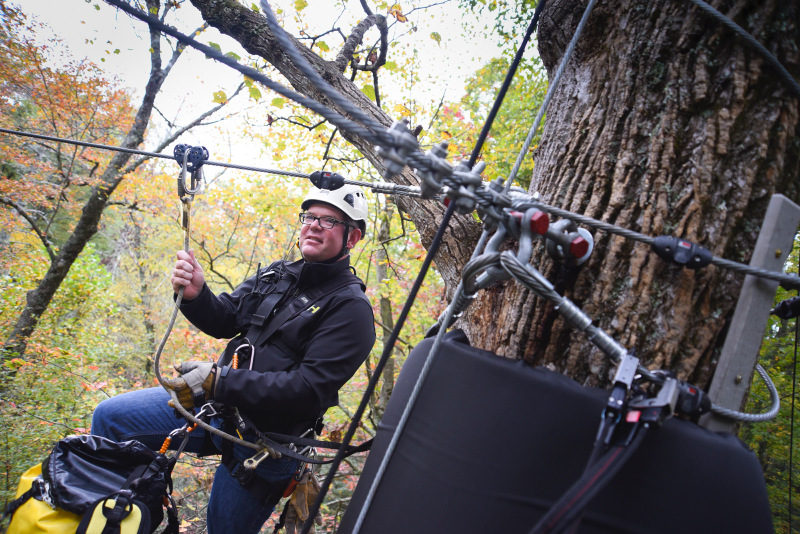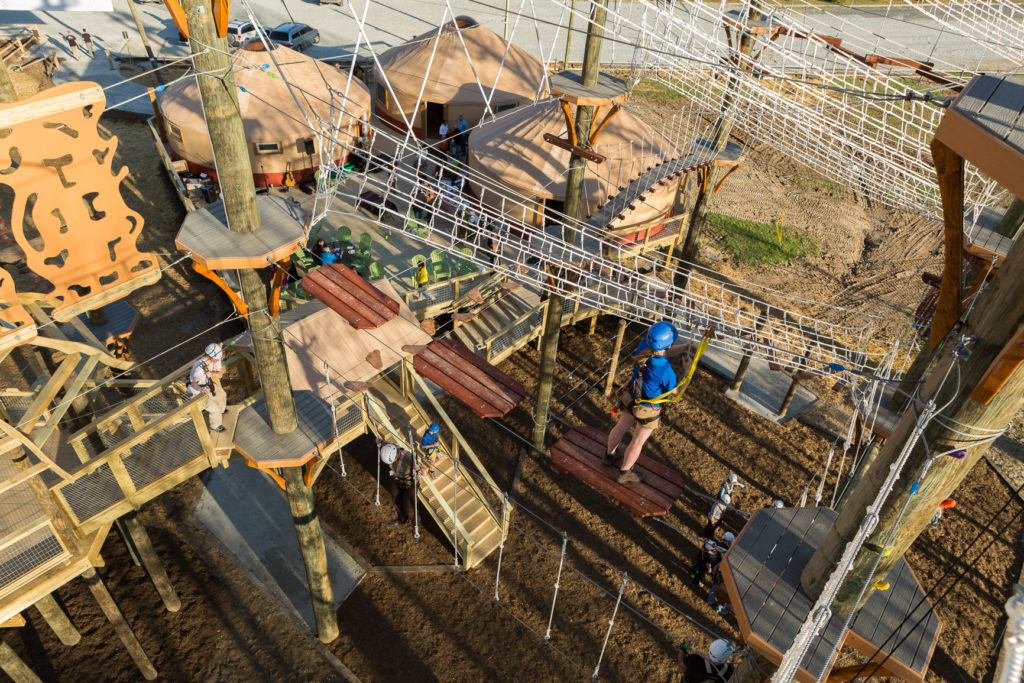Choosing between trees and poles (or a using combination of both) is a critical decision to make early on in your project plan. The experience of moving through a tree-based facility can be magical and result in big savings on the initial installation cost for a comparative size facility built using poles. While many of the components used to build tree-facilities have standardized components that allow for efficient installation, all tree-facilities are by nature custom projects that will require one or more site visits, arbor assessments and whose design will be heavily influenced by the available and accessible trees.
When you build on trees, you are building on a living thing that is susceptible to damage, disease, and infestation. The compromise of a single tree that is part of a larger facility can result in expensive repairs and improvements. Operators of tree facilities will get to know their trees well as annual inspections by a certified arborist are mandated by industry standards and most insurers. In many cases, tree-based facilities will have a shorter lifespan than pole-based facilities; a variable influenced by the species, health, and environmental conditions of the stand.

If you choose to build on trees you will be faced with yet another choice to make; bolted or wrapped. Bolted terminations consist of long nut-eye bolts installed through a drilled hole in the tree. Zip lines and other rigging are built off these bolts. This leaves a neat and tidy finished product without the tree protectors and loops of cable present with wrapped terminations. When done properly, bolts leave a light footprint and allow for unimpeded growth of the tree for many years before corrective action should be taken. Eventually, a tree will consume the bolt preventing proper inspection and mandating replacement. Re-bolting terminations that have been damaged or consumed by tree growth can create problems as terminations often have to be raised or lowered above the original design height.
Wrapped terminations are quick and inexpensive to install and you can simply and easily modify the termination height if necessary. Common to European-influenced facility design, wrapped terminations are a necessity in countries where tree bolting is prohibited and a consideration for property owners wanting to harvest the trees for timber at a later date. Wrapped terminations require annual maintenance and tension adjustments to avoid damage to the tree and associated components. In as little as five years, a tree-based course with wrapped terminations can suffer costly damage if not properly attended and maintained.
Small wooden tree protectors are used in wrapped terminations to keep the cable from directly contacting the tree. While this reduces the likelihood of a tree being girdled by the cable wrap, the protectors themselves can trap moisture and fungus and provide space for insects to burrow and breed. Cyclical loading on wrapped terminations can lead to premature cable wear, another factor that may result in expensive repairs within a short period of time.
While many arborists consider bolting to be the healthier option for tree installations, both termination strategies are accepted practice in the US. Some builders will use either method and many more tend to specialize in one or the other. Challenge Towers chooses to bolt tree installations to reduce impact and extend the effective life of the facility
Poles (wood or steel) open a wide range of design possibilities not possible in trees. Large towers, multi-level courses, and themed attractions can be installed on nearly any site. Small spaces can be turned into high-volume and dynamic facilities and property less suitable for other types of development can be utilized. While tree-based facilities often disappear into the forest, pole-based courses can have dramatic visual presence to roadways or associated attractions. Pole-based design allows you to put what you want, where you want without having to select a sight and design for a specific stand of trees.

Wood poles common to challenge course and aerial park construction can remain structurally viable for decades and are treated to resist infestation and rot. There is no need to have the poles inspected annually and less overall risk associated with their long-term care. The most common issue associated with wood poles is twisting that can occur as the pole dries. This twisting can misalign terminations and other rigging and if serious enough may require adjustment. Twisting is most common in dry environments where the poles are exposed to long periods of sunlight and rarely requires the replacement of the pole itself.
The long-term benefits of pole-based facilities often come with upfront cost. While certain facility designs allow for direct pole embedment in certain soil conditions, other factors may necessitate foundations or other more complex installation methods. While some wood facilities are designed to be freestanding like Challenge Towers award winning WestPark, the majority redirect lateral forces into column load through cable-guys connecting key points of the facility to ground anchors. Some sites and soil conditions present unique challenges when excavating holes for pole embedment and this too may add expense not common to tree-based facilities.
